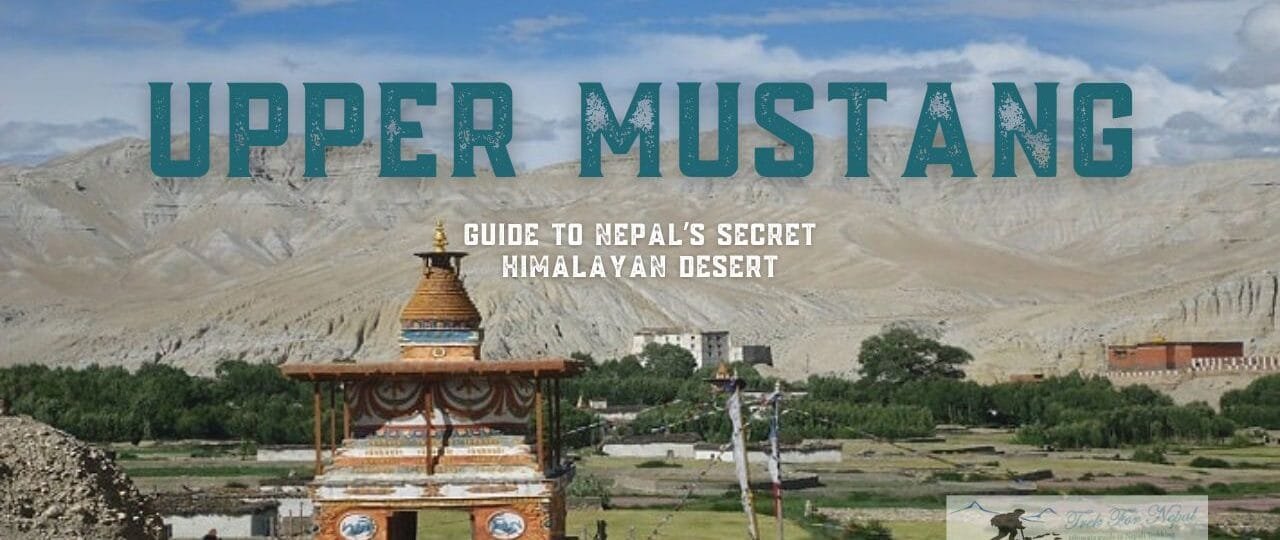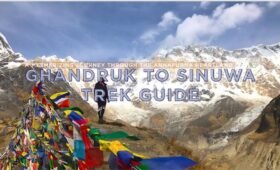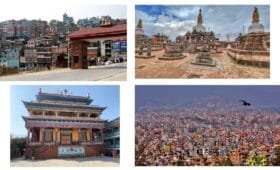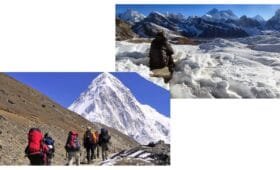The Upper Mustang Trek is a gateway to one of Nepal’s most mysterious and culturally rich regions. Tucked behind the Himalayan rain shadow, It takes you through stark, desert-like vistas, ancient caves, and centuries-old monasteries. Known historically as the Kingdom of Lo, Upper Mustang Trek Nepal reveals a Tibetan-influenced culture that has evolved separately from much of modern Nepal. For those looking to merge an exotic cultural encounter with dramatic landscapes, the Upper Mustang route stands out as a life-changing odyssey.
In this comprehensive guide, we’ll explore the cost of the Upper Mustang Trek, break down a typical itinerary, and discuss how to secure a trek package that suits your budget and style. You’ll learn about the trek’s difficulty and which permits are essential for this restricted region. We’ll also address practical details like the trek distance, referencing a map for route clarity, the ideal time to go, how to choose a guide, recommended accommodation, and the average elevation. Lastly, we’ll touch on the unique local climateand the overall duration of the trek, summarizing everything with highlights and reviews from real trekkers.
1. Introduction: Why the Upper Mustang Trek?
The Upper Mustang Trek is more than just a Himalayan climb; it’s a journey back in time. Locals consider this region a “mini-Tibet,” with Lo Manthang serving as the former capital of a small Himalayan kingdom. Foreigners were restricted from entering until 1992, preserving its deep-rooted culture and untouched desert valleys for decades.
Statistic: According to Nepal’s Department of Immigration, fewer than 5,000 trekkers visit Upper Mustang annually, a fraction of what regions like Annapurna or Everest see. This limited traffic, partly due to the higher Upper Mustang Trek Cost (restricted area permit fees), maintains the region’s mystical aura.
Quote:
“Stepping into Upper Mustang felt like slipping into another century. Monasteries perched on cliffs and red rock canyons shaped an otherworldly backdrop,” recalls Jana, a German trekker who completed her Upper Mustang Trek Nepal earlier this year.
2. Historical & Cultural Overview
Historically, Upper Mustang was part of the Kingdom of Lo, closely linked to Tibet. The region maintained its autonomy despite Nepal’s unification centuries ago, with local kings and a strong Tibetan heritage. Its trade routes once thrived with caravans transporting salt and wool between Tibet and the lowlands.
This cultural mosaic continues to thrive today. Visiting Lo Manthang—the walled city at the heart of the trek—reveals winding alleys, whitewashed houses, and timeless monasteries. Traditional Tibetan Buddhism underpins many local customs. For a deeper cultural connection, consider planning your visit during the Tiji Festival, a vibrant event featuring masked dances that celebrate the triumph of good over evil.
3. Key Highlights of Upper Mustang Trek Itinerary
A typical Upper Mustang trek itinerary lasts 10 to 14 days, starting with a flight or drive from Pokhara to Jomsom, the main gateway to the region.
- Day 1–2: Jomsom to Kagbeni (2,800m)
Jomsom, a breezy settlement in the Kali Gandaki valley, marks the beginning of the trek. You follow the riverbed of the Kali Gandaki to Kagbeni, a medieval village that protects the entrance to Upper Mustang. - Day 3–4: Chele, Syanbochen, Ghami
After registering your restricted area permits at Kagbeni, ascend into the high desert terrain. Red and orange canyon walls enclose the route, dotted with chortens and prayer flags. Nights are spent in small villages like Chele or Syanbochen. - Day 5–7: Tsarang and Lo Manthang
The route ascends to Tsarang, known for its 400-year-old monastery. From there, you continue to Lo Manthang, the walled capital. Discover narrow alleys, impressive palaces, and monasteries adorned with centuries-old murals. - Day 8–9: Chhoser Caves & Exploration
Many include a day’s detour to Chhoser’s ancient caves and multi-story cavities carved into cliff faces historically used as dwellings or religious sanctuaries. - Day 10–12: Return via alternative route. Descend toward Kagbeni, making possible stops at vantage points offering expansive views of the Mustang plateau. Finally, head back to Jomsom for your flight out.
Upper Mustang Trek Distance: The route typically covers 90–120 km, depending on side trips. Yet, the daily hours of walking matter more as the high-altitude desert challenges stamina.
4. Understanding the Upper Mustang Trek Difficulty
The Upper Mustang Trek Difficulty is rated moderate, although some factors elevate its challenge:
- Altitude: While elevations rarely exceed 4,000m, oxygen is thinner than in Nepal’s lower valleys. Lo Manthang sits around 3,800m.
- Harsh Climate: The region’s desert-like environment can expose you to strong winds, scorching days, and chilly nights, requiring layered clothing and robust gear.
- Isolation: Towns are sparse, so daily planning is essential.
Fitness-wise, if you can handle 5–6 hours of daily walking with moderate ascents, you’re set. A basic cardio routine (running, cycling) plus some strength training (lunges, squats) can ease altitude adaptation.
5. Mapping Your Route: A Look at the Upper Mustang Trek Map
Because of the region’s restricted status, an Upper Mustang Trek Map offers more than orientation—it helps you navigate permissible areas. Key sections include:
- Kagbeni: The entry checkpoint is where officials verify your restricted area permits.
- Chele and Syanbochen: Transition from river gorge to high desert.
- Ghami and Tsarang: Historical villages with distinctive red cliffs, large chortens, and walled farmland.
- Lo Manthang: The trek’s apex—a walled city preserving Tibetan-influenced architecture and monastic traditions.
Digital resources exist, but a physical map and a knowledgeable Upper Mustang Trek Guide can reduce route confusion or unplanned detours.
6. How Much Does It Cost? Explaining the Upper Mustang Trek Cost
Upper Mustang Trek Cost can be higher than typical treks in Nepal, mainly due to specialized permit fees. A broad breakdown:
- Restricted Area Permit Fee:
- USD 500 per person for the first 10 days, then ~USD 50 per day for extra days.
- ACAP (Annapurna Conservation Area Permit): ~USD 30.
- TIMS (Trekkers’ Information Management System): ~USD 20–30.
Beyond permits, factor in:
- Guide & Porter: Licensed guides run ~USD 25–40/day, porters ~USD 15–25/day.
- Accommodation & Meals: Teahouse lodging typically costs USD 5–10 per night, with meals costing around USD 20–25 daily.
- Transportation: Flights from Pokhara to Jomsom cost ~USD 120 each way. Overland jeep routes are cheaper but bumpy and longer.
A standard 12-day trek might cost from USD 1,600–2,200 all-inclusive, though premium or private experiences can exceed USD 2,500. Consider an Upper Mustang Trek Package if you prefer someone to handle logistical complexities.
7. Booking the Right Upper Mustang Trek Package
Organizing logistics for Upper Mustang Trekking can be intricate. A well-structured Upper Mustang Trek Package bundles lodging, guides, permits, and sometimes porters or cultural side trips. Evaluate the following:
- Group vs. Private tours are cost-effective but less flexible, while private tours allow itinerary customization.
- Add-ons: Some packages feature side excursions to hidden valleys or local festivals, heightening the cultural payoff.
- Agency Credentials: Ensure the agency is registered, check reviews, and confirm they use licensed guides who know the local culture.
ViN’s Tip: If you’re interested in volunteering or cultural exchanges en route, pick a philanthropic-oriented operator. Some agencies let you combine trekking with community service, fostering deeper local connections.
8. Securing Upper Mustang Trek Permits
Upper Mustang Trek Permits reflect the region’s restricted status. You’ll need:
- Restricted Area Permit:
- Obtainable via the Department of Immigration in Kathmandu or Pokhara.
- Costs USD 500 for the first 10 days (as previously mentioned) and USD 50 for each additional day.
- ACAP (Annapurna Conservation Area Permit):
- ~USD 30.
- TIMS Card:
- ~USD 20–30, mandatory for all treks in Nepal (except certain exceptions for restricted areas).
Present your passport, visa, and extra passport photos. If your Upper Mustang Trek Package is booked, agencies often handle these permits on your behalf.
9. Upper Mustang Trek Best Time: Seasons & Weather
Because of Mustang’s rain-shadow geography, Upper Mustang Trek Weather differs from typical Nepal monsoons. Autumn and spring remain popular, but summer suits trekking if you can handle warmer days.
9.1 Spring (Mar-May)
- Temperatures: Daytime ~15–20°C, nights dipping near 5–10°C.
- Blooming slopes near lower sections—though the upper region’s desert stays primarily arid.
9.2 Summer/Monsoon (Jun–Aug)
- Upper Mustang is shielded mainly by the Annapurna range, unlike other regions battered by rain. There is occasional drizzle, but it is primarily passable.
- Fewer crowds, making it a prime time for solitude-seekers.
9.3 Autumn (Sept–Nov)
- Arguably, the Upper Mustang Trek is the Best Time—cool mornings, stable weather, and crystal-clear vistas of canyons and peaks.
- Tiji Festival sometimes falls in late spring or summer, but autumn has its festivals worth observing.
9.4 Winter (Dec–Feb)
- Freezing nights, with dryness dominating. Some lodges or routes might close if snow accumulates on passes.
- Perfect for travelers seeking near-zero crowds, but expect sub-zero nights above 3,500m.
10. Hiring an Upper Mustang Trek Guide
While an Upper Mustang Trek Guide isn’t strictly mandatory (aside from the restricted area condition that requires a group of at least two plus a licensed guide or an expensive solo permit arrangement), it immensely aids your journey:
- Cultural Facilitation: Guides interpret local traditions, bridging language gaps.
- Route Navigation: Desert-like terrains can confuse novices. A guide ensures correct footpaths and avoids restricted border areas.
- Permit Compliance: They manage check-ins at checkpoints and clarify region-specific rules.
- Emergency Readiness: If altitude sickness or injuries arise, they coordinate immediate help.
Expect daily guide rates of ~USD 25–35, plus a tip. If you prefer a comfortable trek, hire a porter for ~USD 15–25/day to carry your heavier gear.
11. Preparation & Tips for Success
11.1 Physical Preparation
- Cardio: Running, swimming, or biking 3–4 times a week for at least a month.
- Leg Strength: Weighted squats or stair exercises.
- Acclimatization: Some travelers do short warm-up hikes near Pokhara before heading to Jomsom.
11.2 Packing & Gear
- Layers: Warm base layers, fleece or down jacket for chilly nights, windproof outer shell.
- Footwear: Broken-in boots plus trekking poles for stable footing on rocky trails.
- Essentials: Sunglasses, high-SPF sunscreen (the sun is intense at altitude), and a water purifier.
11.3 Cultural Sensitivity
You’re in a profoundly Tibetan-influenced zone. Respect locals’ beliefs, ask them before photographing them or religious sites and keep noise levels modest near monasteries. Local meals (like tsampa or Tibetan bread) can further the immersion.
12. Stories from the Trail: Testimonials & Inspiration
Camille’s Experience
Camille, a 31-year-old teacher from France, recalls arriving in Lo Manthang: “It felt surreal. The wind-swept desert and red-walled city looked straight from a medieval Tibetan painting. I chatted with a monk who explained the Tiji Festival’s masked dances. It was pure cultural immersion.”
Community Impact
Beyond tourism, trekking fosters local economies. Tsering, who owns a teahouse near Ghami, states: “Each visitor who stays or buys a meal helps keep our old traditions alive. We’re proud to share the stories of our land.”
FAQs
13. Seven Most Frequently Asked Questions
How long is the Upper Mustang Trek Duration?
The trek averages 10–14 days, depending on your start and end points or potential side trips.
What is the Upper Mustang Trek Difficulty?
It is moderately challenging. The trails are not extremely steep, but the desert climate and altitude near 4,000m can be tough.
How much does the Upper Mustang Trek Cost?
Permit fees alone cost USD 500 for the first 10 days. Transport, lodging, and a guide are included, and a 12-day itinerary costs USD 1,600–2,200 or more.
When is the Upper Mustang Trek Best Time?
Spring (May), Autumn (September–November), and even the summer monsoon season can be favorable because the region is in a rain shadow.
Do I need special Upper Mustang Trek Permits?
Yes. You need a restricted area permit (USD 500 for 10 days) plus ACAP (~USD 30) and a TIMS card (~USD 20–30). Guides are mandatory for two or more trekkers in a group.
Where can I get an Upper Mustang Trek Map?
Trekking shops in Kathmandu or Pokhara. If you hire a guide, they often supply route maps or share digital copies.
Is it possible to volunteer while in Upper Mustang?
Yes, if arranged in advance. Nonprofits like Volunteers Initiative Nepal (ViN) can coordinate education, health, or cultural preservation projects that integrate with trekking routes.
14. Conclusion & Inspiring Call to Action for ViN
Ultimately, the Upper Mustang Trek invites you to walk a path few have seen, bridging the gap between the everyday world and an ancient Himalayan kingdom. This desert-like corridor with Tibetan monasteries stands apart from standard Nepalese treks—it is culturally distinctive and visually stunning. Whether you’re an experienced trekker hungry for a hidden gem or a culture enthusiast aiming to witness living Tibetan traditions, Upper Mustang Trekking promises to exceed expectations.
Empower Your Journey with ViN
At Volunteers Initiative Nepal (ViN), we believe in weaving altruism into your travels. If you’re yearning for deeper engagement, try:
- Volunteering: Devote spare trek days to local educational or conservation projects.
- Interning: Use your academic or professional expertise to assist community-led initiatives—like language programs or research.
- Donating: Help local clinics, schools, or environmental efforts in Upper Mustang, ensuring your trip benefits the region long after you depart.
- Sharing: Spread the word among fellow travelers, encouraging them to combine adventure with meaningful impact.
Your footsteps across these ancient pathways can resonate far beyond personal growth. By giving back, you enhance the synergy between visitor and host, enabling local traditions to flourish while forging a future of sustainable tourism. Embark not just on a trek but on a journey of cultural exchange and altruistic spirit.
Namaste, and see you in the hidden realm of Upper Mustang.
Additional Info
Additional Info & Practical Guidelines
To bolster your readiness, expand on specific aspects of the Upper Mustang Trek that can refine your experience and ensure a safe, culturally aware journey.
1. Seasonal Variations & Weather
1.1 Summer Nuance
Even in monsoon, Upper Mustang Trek Weather remains relatively dry, with occasional light showers. Rivers can swell, though local routes typically remain passable. The advantage is quieter trails.
1.2 Winter Preparations
In winter, nighttime temperatures frequently drop below -10°C at higher altitudes. Teahouse closures in the deepest winter can limit accommodation options, requiring more planning or advanced booking.
2. Teahouse Culture & Upper Mustang Trek Accommodation
Teahouse lodging lines the route, though they are sparser than Annapurna or Everest corridors. Rooms feature two beds with essential bedding, and communal dining areas revolve around wood stoves or yak-dung fires. Pricing can be slightly higher than typical Nepali teahouses, reflecting the difficulty of transporting supplies into a remote region.
Hot Showers & Wi-Fi
Expect additional fees (USD 2–5) if you want hot showers or limited Wi-Fi. Solar power can be unpredictable, so charge gadgets early in the evening. As an eco-friendly measure, pack a quick-dry towel and consider portable charging solutions.
3. Cultural Etiquette & Restricted Zones
3.1 Monastery Manners
Remove shoes before entering temples. Speak softly and show respect during prayers. Photography might be restricted—always ask a monk or caretaker.
3.2 Section Boundaries
Restricted zones beyond Lo Manthang require extended permits. If your itinerary includes them, ensure your guide organizes the correct passes. Given the region’s sensitive borderlands with Tibet, the local culture strongly discourages off-route wandering.
4. Safety & Health Provisions
4.1 Altitude & AMS
Though the Upper Mustang Trek Elevation seldom tops 4,000m, altitude sickness remains possible. Drink at least 3 liters daily, consider mild AMS medication like Diamox (with medical advice), and rest if you get headaches or dizziness.
4.2 Evacuation & Insurance
Helicopter rescues can be arranged from points near Kagbeni or Lo Manthang if you face severe illness or injury. Double-check your travel insurance covers high-altitude trekking (above 3,500m) and helicopter airlifts.
5. Unique Upper Mustang Trek Highlights
5.1 Lo Manthang’s Secret
Stone walls encircle the city, and entering feels like crossing into a medieval fortress. Explore its intricately painted gompas (monasteries) and labyrinthine streets. If time allows, check out the local museum for Himalayan artifacts.
5.2 Caves & Cliff Dwellings
Myriad cliff caves in Upper Mustang date back centuries. Archaeologists discovered pottery shards, Tibetan scripts, and even human remains, indicating how these caves served as dwellings or spiritual retreats.
5.3 Tiji Festival
Often scheduled in late spring or early summer, Tiji is a highlight for those lucky to coincide. Masked dancers re-enact Buddhist myths, culminating in vivid displays of faith and color. Attending Tiji can transform your entire trek into a cultural immersion.
6. Potential Side Trips
- Chhoser Cave System: A half-day outing from Lo Manthang reveals multi-story caves carved into vertical cliffs.
- Namgyal Monastery: Perched atop a rocky ridge, it’s a perfect vantage point for panoramic photography.
- Drakmar: This village is famous for red rock cliffs and legends about Guru Rinpoche’s footprints.
7. Combining Trek with Volunteer Opportunities
Through Volunteers Initiative Nepal (ViN):
- Education Projects: If time permits, offer short lessons in English or math at community learning centers near Kagbeni or Chele.
- Health & Sanitation: Some villages lack basic healthcare infrastructure; volunteers with medical backgrounds can assist health posts or run awareness programs.
- Cultural Documentation: Photographers or researchers might partner with local authorities to document intangible heritage, such as oral histories or monastery records.
8. Post-Trek Experiences
After concluding your Upper Mustang Trek Duration, many travelers spend a day or two relaxing in Pokhara or Kathmandu, exploring cafes, gear shops, or cultural landmarks:
- Pokhara: Lakeside strolls, paragliding, or short hikes to Peace Pagoda.
- Kathmandu: Visits to UNESCO sites like Boudhanath, Pashupatinath, or Patan Durbar Square.
- Reflections: Evaluate your trek’s impact. Possibly, plan a return to exploring neighboring routes (like the Annapurna Circuit or Nar Phu Valley).
9. Overcoming Road Encroachments
Road construction has extended from Jomsom toward Lo Manthang, making certain sections accessible by jeep or bus. While this might reduce foot-based isolation, it also simplifies logistics for those who are short on time. Purists lament the potential shift away from raw adventure; others appreciate the convenience. Decide what suits your trekking ethos.
Final Words
The Upper Mustang Trek is a crossroads between cultural heritage and Himalayan grandeur. Each village, cliffside dwelling, or monastery in this region quietly guards centuries of history. Crossing these ancient trade routes fosters a renewed sense of humility and perspective for some. For others, it’s the rare chance to step into a hidden world, physically protected by towering peaks and spiritually insulated by deep Tibetan roots.
Call from ViN
At Volunteers Initiative Nepal (ViN), we envision a tourism model that uplifts local communities, preserves cultural identity, and enriches travelers. You invest in the region’s resilience by weaving your Upper Mustang Trekking experience with volunteer projects—health, education, or cultural conservation.
- Volunteer: Offer your time, talents, or language skills to local schools or health outposts.
- Intern: Engage in field research or help document intangible heritage—like folk tales, religious artifacts, or settlement histories.
- Donate: Support grassroots programs that target sanitation, renewable energy, or youth mentorship in remote Himalayan villages.
- Share: Spread your experiences, encouraging others to combine adventure with empathy. A single story can inspire more travelers to adopt conscientious travel habits.
Ready to surpass ordinary tourism? Let your steps through these deserted canyons symbolize a deeper bond between visitor and host. Through synergy with local communities, you champion an approach to trekking that fosters mutual respect, preserves living Tibetan-Buddhist culture, and paves the way for future generations.
Namaste—we await your footprints in the mystical labyrinth of Upper Mustang.




